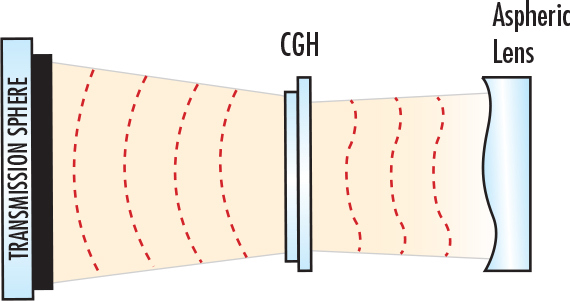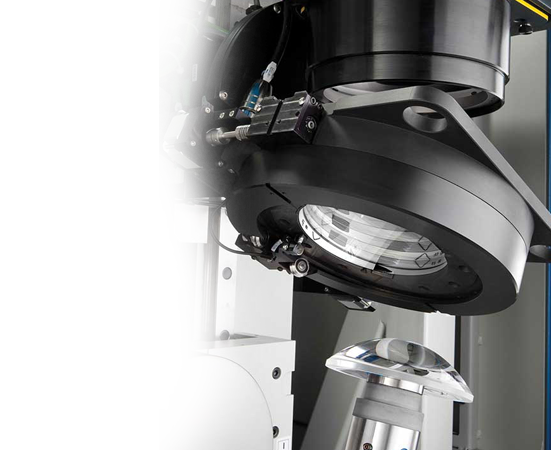

|
|
Capture non-rotationally symmetric surface irregularity |
|
|
Reduce measurement time by up to a factor of 3 compared to scanning methods |
|
|
High accuracy of λ/10 or below |
|
|
Only method to measure aspheric shapes with a high slope of aspheric departure |
Computer Generated Hologram metrology is a promising solution to several of the drawbacks associated with traditional metrology techniques for aspheric lenses. Aspheres are vital to a variety of applications because they allow for a reduction in spherical aberrations and can achieve a low f/#. However, measuring aspheres is much more difficult than standard spherical lenses. Computer Generated Holograms (CGHs) provide an effective means of quantifying the surface irregularity of aspheric lenses by converting spherical reference wavefronts into aspheric wavefronts that match the surface sag of the asphere. Aspheric surfaces are typically measured using scanning equipment, but using CGHs allow them to be measured more quickly and with higher accuracy.
Background information on interferometry and holography is necessary for understanding CGHs metrology:
The surfaces of aspheres have departure from their best fit reference sphere and this increased optical path difference creates fringes so dense that they can no longer be resolved by the imaging system of the interferometer. This problem can be solved by using a Computer Generated Hologram, which is an interference pattern that converts the spherical wavefront leaving the reference sphere into an aspheric wavefront that matches the ideal surface sag of the aspheric lens.

Transforming the best-fit spherical wavefront into an aspheric wavefront is extremely beneficial as the calibrated reference wavefront allows the interference fringes to be resolved and the surface irregularity of the asphere to be precisely measured.
While other methods exist for measuring aspheric surfaces, such as contact profilometers, optical profilometers, and aspheric stitching interferometers, CGHs have numerous benefits that outweigh those options including:
However, CGH’s require a higher up-front cost compared to other metrology methods because a unique CGH is required for each specific aspheric prescription. If small quantities of an asphere are being measured, CGH metrology will not be cost effective, but will lead to significant long-term savings for volume manufacturing. For volume production, the reduced measurement time of CGH metrology makes it the optimal choice for asphere metrology.

Edmund Optics® is taking advantage of Computer Generated Holograms to push the boundaries of our in-house aspheric metrology. CGH metrology gives us the ability to reduce measurement time on our high volume, manufactured aspheres and also make surface irregularity measurements with higher accuracy than conventional asphere metrology. This technique expands our aspheric manufacturing capabilities by allowing us measure aspheric shapes with a high slope of aspheric departure that could not be measured through other metrology methods.
While we do not sell CGHs for measuring aspheric lens surfaces, we do sell CGHs for measuring cylindrical optics made by Arizona Optical Metrology (AOM). Lean more and buy now here.
CGH metrology reduces the time spent measuring each part compared to typical scanning techniques for aspheric metrology and can also make more accurate surface irregularity measurements. CGH metrology has the additional benefits of identifying non-rotationally symmetric surface irregularity and being able to measure surfaces with a higher slope of aspheric departure.
There is a higher up-front cost to using a CGH since a unique CGH is needed for a specific aspheric surface. If small quantities of an asphere are being measured then CGH metrology won’t be cost effective, but will lead to significant long-term savings for volume manufacturing. In addition, when using a CGH transmission and reflection of unwanted diffraction orders can cause ghost fringes in the interferogram; care must be taken to tune diffraction efficiency and separate the diffraction orders to avoid this.
No, each CGH is designed to measure one particular aspheric prescription.
Yes, CGH metrology is sometimes implemented to measure other non-spherical surfaces such as cylinder lenses and freeforms.
CGH metrology accuracy is limited by pattern placement error in etching the interference pattern onto the substrate as well as alignment error of the CGH to the interferometer. Often, a CGH will have an alignment feature or built-in mount to mitigate the alignment error.
A CGH has a minimum feature size in its interference pattern that limits the maximum possible diffraction angle. This is why an aspheric CGH is often used along with a reference sphere in the interferometer to reduce the required diffraction angles.>
or view regional numbers
QUOTE TOOL
enter stock numbers to begin
Copyright 2023 | Edmund Optics, Ltd Unit 1, Opus Avenue, Nether Poppleton, York, YO26 6BL, UK
California Consumer Privacy Act (CCPA): Do Not Sell or Share My Personal Information
California Transparency in Supply Chains Act